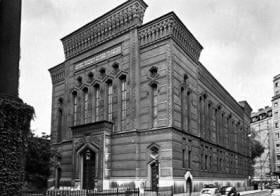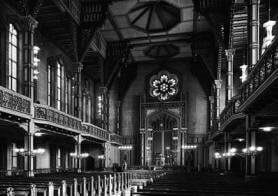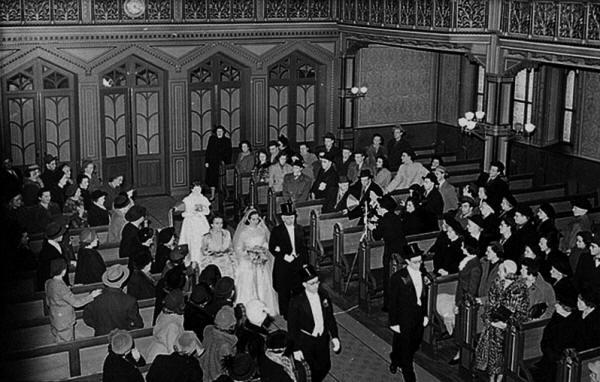The Great Synagogue of Stockholm, Sweden
Haim F. Ghiuzeli
The largest and the oldest of the three synagogues of Stockholm, the Great Synagogue (Stora Synagogan, in Swedish) is located in the city center, close to Berzeli Park and not far away from Gamla Stan (the Old town of Stockholm). The Great Synagogue was inaugurated in 1870, the same year when the last restrictions on the legal status of Jews living in Sweden were abolished and they were finally granted full emancipation. The Great Synagogue replaced an earlier synagogue that was established in Stockholm in 1795. Ever since its inauguration, the Great Synagogue of Stockholm has served as the focal point of the Jewish life in the city and indeed in the whole of Sweden.
The construction work of the Great Synagogue continued for three years from 1867 until 1870 according to the plans of the outstanding 19th century Swedish architect Fredrik Wilhelm Scholander (1816-1881). The Great Synagogue is a remarkable edifice built of bricks in a style which according to Scholander’s own description is reminiscent of “the oriental lands”. It is a large building that can sit 900 people; a capacity that is even more impressive when recalling that at the time of the synagogue’s opening the entire Jewish community of Stockholm had less than two thousands members. By its style and dimensions the Great Synagogue of Stockholm continues the line of monumental synagogues that started to be erected all over Europe and included such outstanding buildings as the New Synagogue in Oranienburger Straße of Berlin (built 1859-1866, destroyed in 1938) and the Great Synagogue in Dohany Street of Budapest (built 1854-1859). The style of these synagogues, inspired from the oriental architecture, especially Moorish, was intended to evocate the glorious past of the Jewish people in the land of Israel and in medieval Spain, while the size and location of the synagogues in the city centers expressed the newly acquired legal status and social respectability of the Jewish community.
The western façade of the Great Synagogue of Stockholm is dominated by a richly decorated cornice and is divided into three parts with the central section higher than the two lateral ones. Five high lancet windows occupy the central section of the façade above the main entrance. The Hebrew inscription between the windows and the cornice is a quote from the Bible: “And let them make me a sanctuary; that I may dwell among them” (Exodus, 25:8). The same decorative motifs are repeated on the lateral sections of the facade. The side walls too are dominated by the cornice at both their western and eastern edges that are higher than the central sections which display four groups of three lancet windows at the first store. The eastern end repeats the decorative elements of the western façade: it is dominated by the same cornice and divided into three sections. The five windows of the western façade have been replaced on the eastern wall by a rose window with six petals suggesting the Star of David (Magen David) located at the center of the eastern façade, inside a hexagon sustained by columns and circumscribed by a golden inscription in Hebrew.
The interior has a main prayer hall with a balcony for the women section around the lateral walls as well as on the western wall. The high ceiling boasts a row of small octagonal cupolas and is sustained by two rows of columns. The architecture of the Great Synagogue of Stockholm embodies both Jewish traditional elements, such as a separate section for women, and the innovative approach to the synagogue architecture introduced by the Reform Judaism of Germany at the middle years of the 19th century. The bimah is located at the eastern end of the prayer hall, in front of the Holy Ark. The eastern wall is dominated by the rose window just above the Holy Ark. The decoration of the Holy Ark repeats the ornamental elements of the eastern façade and was believed to resemble an Assyrian sanctuary. Two imposing chandeliers are situated at both sides of the bimah and a large menorah stands at the right side.
The Great Synagogue of Stockholm is affiliated to the movment of progressive Judaism; originally it served a Reform congregation, but currently it is a Conservative synagogue. As in German Reform synagogues of the 19th and early 20th century, the services at the Great Synagogue of Stockholm are accompanied by an organ, played by a non-Jewish musician on Friday nights, Shabbat mornings and major holidays, and a mixed choir. The balconies are reserved for women, while the left side of floor level is reserved for men. Mixed sitting is permitted on the right side of the floor. Services are held in Swedish and in Hebrew on Shabbat, holidays, and every Monday, Thursday, and Rosh Chodesh (the first day of a month in the Jewish calendar).
The headquarters of the Jewish Community of Stockholm are located in the building next to the Great Synagogue. The Jewish Community Library is situated beneath the Great Synagogue and has a collection of books in Swedish, English, Hebrew, Yiddish, German and other languages and includes books from the library of Rabbi Marcus (Mordechai) Ehrenpreis (1869-1951), Chief Rabbi of Sweden (1914-1951).
The Monument to the memory of the Holocaust victims is located on the premises of the Great Synagogue on the wall connecting the synagogue with the adjacent offices of the Jewish community. The 42 meter wall bears inscriptions with the names of about 8,500 relatives of Jews living in Sweden, who perished in the Holocaust. In front of the wall there is a large menorah, a gift of the Swedish government. The monument, by Sivert Lindnlom, was dedicated by Carl XVI Gustav, the King of Sweden, in 1998.
The Great Synagogue of Stockholm has been recognized as a Swedish national historical building.
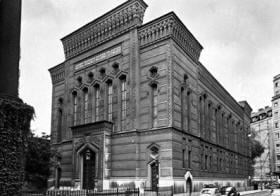
Exterior view of the Great Synagogue of Stockholm. Postcard. The Oster Visual Documentation Center, ANU - Museum of the Jewish People. Courtesy of Pinhas Shahar, Israel
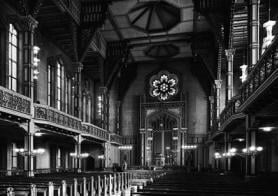
Interior view of the Great Synagogue of Stockholm. Postcard. The Oster Visual Documentation Center, ANU - Museum of the Jewish People. Courtesy of Pinhas Shahar, Israel
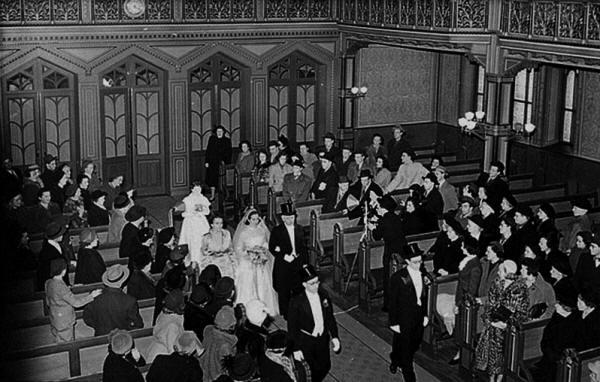
Wedding ceremony at the Great Synagogue of Stockholm, April 8, 1951. The Oster Visual Documentation Center, ANU - Museum of the Jewish People. Courtesy of Alex Zielony, Israel
Addresses:
Stora Synagogan
Wahrendorffsgatan 3b
10391 Stockholm
Sweden
Phone: 46-8-587 858 00
Fax: 46-8-587 858 58
